TheDeveloperBlog.com
C-Sharp | Java | Python | Swift | GO | WPF | Ruby | Scala | F# | JavaScript | SQL | PHP | Angular | HTML
Integrating LinkedIn API in Android App
Integrating LinkedIn API in Android App with examples of Activity and Intent, Fragments, Menu, Service, alarm manager, storage, sqlite, xml, json, multimedia, speech, web service, telephony, animation and graphics
Integrating LinkedIn API in Android AppIn this tutorial, we will integrate the LinkedIn Sign-In functionality in our Android application. Implementing LinkedIn API in Android app helps users to login using LinkedIn account, share post, etc. For integrating the LinkedIn API in our Android app, we need the LinkedIn Authentication Key (Client ID and Client Secret) and app Hash Key. Steps to generate LinkedIn Authentication Key and APP Hash Key
1. Create LinkedIn developer account at https://www.linkedin.com/developer/apps and click on 'Create Application'. 
2. Fill all the required details of Android application in 'Create a New Application' form and accept the LinkedIn API Terms of Use then click 'Submit'. 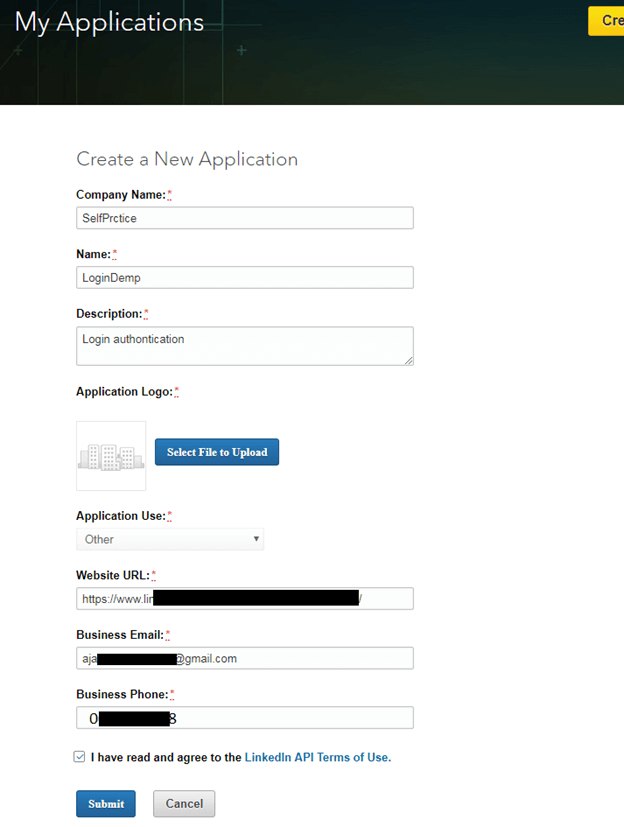
3. After submitting the application details, it generates LinkedIn Authentication Key. Now we will select the 'Default Application Permissions'. This permission authorizes to access privilege of user account. Here, we are selecting r_basicprofile, and 'r_emailaddress' and click 'Update'. 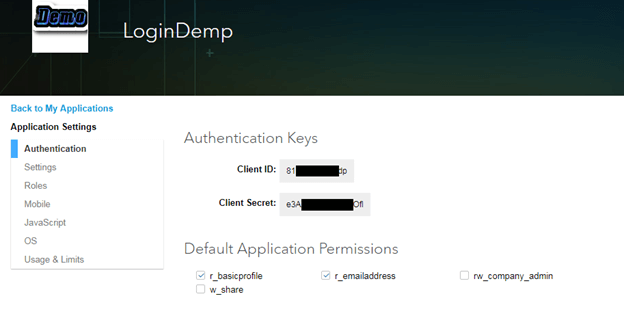
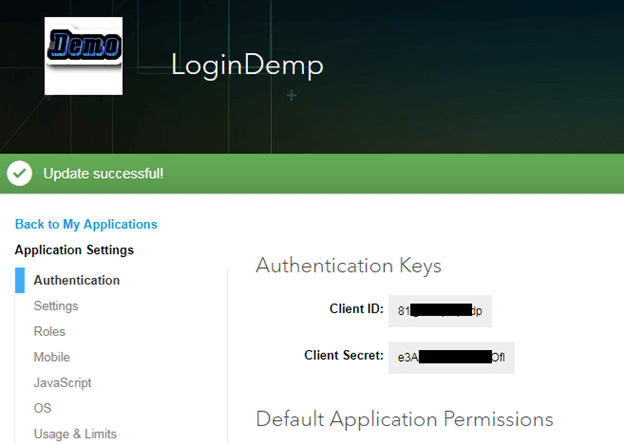
4. Now, we need the 'Hash Key' for our app. It can be generated by two different ways.
Windows: keytool -exportcert -keystore %HOMEPATH%\.android\debug.keystore -alias androiddebugkey | openssl sha1 -binary | openssl base64 Mac/Unix keytool -exportcert -keystore ~/.android/debug.keystore -alias androiddebugkey | openssl sha1 -binary | openssl base64 To generate the Hash Key through command prompt, it requires OpenSSL to be installed in our operating system. We can download it for Windows from www.slproweb.com/products/Win32OpenSSL.html and for Mac/Unix from http://www.openssl.org/source/ .
PackageInfo info = getPackageManager().getPackageInfo(
"Your Package Nane",
PackageManager.GET_SIGNATURES);
for (Signature signature : info.signatures) {
MessageDigest md = MessageDigest.getInstance("SHA");
md.update(signature.toByteArray());
Log.d("KeyHash:", Base64.encodeToString(md.digest(), Base64.DEFAULT));
For this application, we will use the programming code to generate 'Hash Key' for our application. Now create our application and simply write the following code and run to generate our 'Hash Key'. It will show the application 'Hash Key' in Logcat. MainActivity.java
package example.com.linkedinlogindemo;
import android.content.pm.PackageInfo;
import android.content.pm.PackageManager;
import android.content.pm.Signature;
import android.support.v7.app.AppCompatActivity;
import android.os.Bundle;
import android.util.Base64;
import android.util.Log;
import java.security.MessageDigest;
public class MainActivity extends AppCompatActivity {
public static final String PACKAGE = "example.com.linkedinlogindemo";
@Override
protected void onCreate(Bundle savedInstanceState) {
super.onCreate(savedInstanceState);
setContentView(R.layout.activity_main);
computePakageHash();
}
private void computePakageHash() {
try {
PackageInfo info = getPackageManager().getPackageInfo(
"example.com.linkedinlogindemo",
PackageManager.GET_SIGNATURES);
for (Signature signature : info.signatures) {
MessageDigest md = MessageDigest.getInstance("SHA");
md.update(signature.toByteArray());
Log.d("KeyHash:", Base64.encodeToString(md.digest(), Base64.DEFAULT));
}
} catch (Exception e) {
Log.e("TAG",e.getMessage());
}
}
}
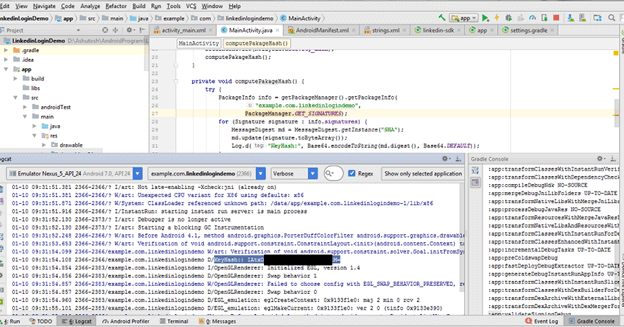
5. Copy the 'Hash Key' from Logcat and paste it in Mobile tab of our LinkedIn application. After that click on 'Add' and 'Update'. This makes our application 'Hash Key' registered with LinkedIn API. 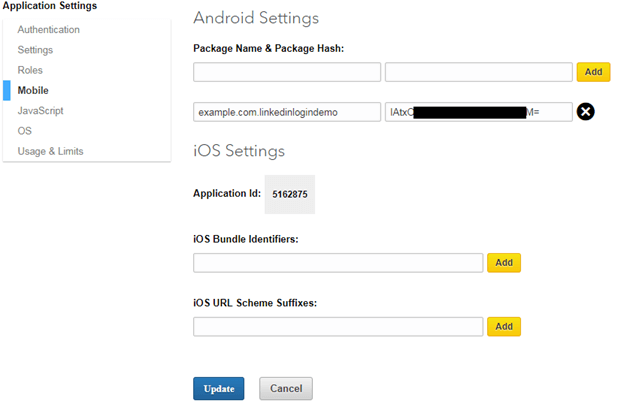
Example to Integrate LinkedIn Login in Android app
Let's create an example of integrating the LinkedIn log-in functionality in our Android application. After successful user log-in, it will redirect user to another activity (ProfileActivity) and display the user information. We need to add the LinkedIn SDK for Android in our project. It can be downloaded from here https://developer.linkedin.com/downloads#androidsdk. 
Required Permission
Add the Internet permission in AndroidMenifest.xml file. <uses-permission android:name="android.permission.INTERNET" /> settings.gradleAdd the linkedin-sdk in settings.gradle file. include ':app', ':linkedin-sdk' build.gradle (Module)Add the compile project(path: ':linkedin-sdk') in build.gradle file.
dependencies {
implementation fileTree(dir: 'libs', include: ['*.jar'])
implementation 'com.android.support:appcompat-v7:26.1.0'
implementation 'com.android.support.constraint:constraint-layout:1.0.2'
testImplementation 'junit:junit:4.12'
androidTestImplementation 'com.android.support.test:runner:1.0.1'
androidTestImplementation 'com.android.support.test.espresso:espresso-core:3.0.1'
compile project(path: ':linkedin-sdk')
}
activity_main.xmlAdd the following code in activity_main.xml file. Download the recommended LinkedIn button from LinkedIn developer site https://developer.linkedin.com/downloads and add it as the background of button.
<?xml version="1.0" encoding="utf-8"?>
<RelativeLayout xmlns:android="http://schemas.android.com/apk/res/android"
xmlns:app="http://schemas.android.com/apk/res-auto"
xmlns:tools="http://schemas.android.com/tools"
android:layout_width="match_parent"
android:layout_height="match_parent"
tools:context="example.com.linkedinlogindemo.MainActivity">
<TextView
android:id="@+id/textView"
android:layout_width="wrap_content"
android:layout_height="wrap_content"
android:layout_alignParentTop="true"
android:textSize="20dp"
android:layout_centerHorizontal="true"
android:text="This is Login Page" />
<Button
android:id="@+id/login_button"
android:layout_width="wrap_content"
android:layout_height="wrap_content"
android:layout_alignParentBottom="true"
android:layout_centerHorizontal="true"
android:layout_marginBottom="17dp"
android:background="@drawable/loginbutton"
tools:layout_editor_absoluteX="58dp"
tools:layout_editor_absoluteY="437dp" />
</RelativeLayout>
MainActivity.javaIn the MainActivity.java class, we use the LISessionManager class which provides all functionality to create and manage the LISession object (LinkedIn session object). In the build, scope adds the 'Scope.R_BASICPROFILE' and 'Scope.R_EMAILADDRESS' to access user basic profile information and email address of LinkedIn.
package example.com.linkedinlogindemo;
import android.content.Intent;
import android.support.v7.app.AppCompatActivity;
import android.os.Bundle;
import android.view.View;
import android.widget.Button;
import android.widget.TextView;
import android.widget.Toast;
import com.linkedin.platform.LISessionManager;
import com.linkedin.platform.errors.LIAuthError;
import com.linkedin.platform.listeners.AuthListener;
import com.linkedin.platform.utils.Scope;
public class MainActivity extends AppCompatActivity {
Button loginBtn;
TextView textView;
@Override
protected void onCreate(Bundle savedInstanceState) {
super.onCreate(savedInstanceState);
setContentView(R.layout.activity_main);
loginBtn = (Button) findViewById(R.id.login_button);
textView=(TextView)findViewById(R.id.textView);
loginBtn.setOnClickListener(new View.OnClickListener() {
@Override
public void onClick(View view) {
loginHandle();
}
});
}
public void loginHandle() {
LISessionManager.getInstance(getApplicationContext()).init(MainActivity.this, buildScope(), new AuthListener() {
@Override
public void onAuthSuccess() {
// Authentication was successful. You can now do other calls with the SDK.
Intent intent=new Intent(MainActivity.this,ProfileActivity.class);
startActivity(intent);
}
@Override
public void onAuthError(LIAuthError error) {
// Handle authentication errors
Toast.makeText(getApplicationContext(),"Login Error "+error.toString(),Toast.LENGTH_LONG).show();
}
}, true);
}
private static Scope buildScope() {
return Scope.build(Scope.R_BASICPROFILE, Scope.R_EMAILADDRESS);
}
@Override
protected void onActivityResult(int requestCode, int resultCode, Intent data) {
// Add this line to your existing onActivityResult() method
LISessionManager.getInstance(getApplicationContext()).onActivityResult(this, requestCode, resultCode, data);
}
}
activity_profile.xmlNow, add the following code in activity_profile.xml file. In this activity, we will display the user information after successful login.
<?xml version="1.0" encoding="utf-8"?>
<LinearLayout xmlns:android="http://schemas.android.com/apk/res/android"
xmlns:app="http://schemas.android.com/apk/res-auto"
xmlns:tools="http://schemas.android.com/tools"
android:layout_width="match_parent"
android:layout_height="match_parent"
android:orientation="vertical"
android:gravity="center_horizontal"
tools:context="example.com.linkedinlogindemo.ProfileActivity">
<TextView
android:layout_width="wrap_content"
android:layout_height="wrap_content"
android:text="Welcome to profile" />
<TextView
android:layout_width="wrap_content"
android:layout_height="wrap_content"
android:id="@+id/userDetail"
android:text="userdetail"
android:layout_marginTop="20dp"
/>
<Button
android:layout_width="wrap_content"
android:layout_height="wrap_content"
android:layout_marginTop="30dp"
android:textColor="#FFF"
android:text="logout"
android:id="@+id/logout_button"
android:background="#022885"
/>
</LinearLayout>
ProfileActivity.javaAdd the LinkedIn API URL https://api.linkedin.com/v1/people/~:(id,first-name,last-name,email-address) in getRequest() method of APIHelper class. It will retrieve the user information on success of LinkedIn API.
package example.com.linkedinlogindemo;
import android.content.Intent;
import android.support.v7.app.AppCompatActivity;
import android.os.Bundle;
import android.view.View;
import android.widget.Button;
import android.widget.TextView;
import android.widget.Toast;
import com.linkedin.platform.APIHelper;
import com.linkedin.platform.LISession;
import com.linkedin.platform.LISessionManager;
import com.linkedin.platform.errors.LIApiError;
import com.linkedin.platform.listeners.ApiListener;
import com.linkedin.platform.listeners.ApiResponse;
import org.json.JSONException;
import org.json.JSONObject;
public class ProfileActivity extends AppCompatActivity {
TextView user_detail;
String firstName,lastName,userEmail;
Button logout;
@Override
protected void onCreate(Bundle savedInstanceState) {
super.onCreate(savedInstanceState);
setContentView(R.layout.activity_profile);
user_detail=(TextView)findViewById(R.id.userDetail);
logout=(Button)findViewById(R.id.logout_button);
fetchuserData();
logout.setOnClickListener(new View.OnClickListener() {
@Override
public void onClick(View view) {
LISessionManager.getInstance(getApplicationContext()).clearSession();
Toast.makeText(getApplicationContext(),"Logout Successfully",Toast.LENGTH_LONG).show();
Intent intent = new Intent(ProfileActivity.this, MainActivity.class);
startActivity(intent);
}
});
}
private void fetchuserData() {
String url = "https://api.linkedin.com/v1/people/~:(id,first-name,last-name,email-address)";
APIHelper apiHelper = APIHelper.getInstance(getApplicationContext());
apiHelper.getRequest(this, url, new ApiListener() {
@Override
public void onApiSuccess(ApiResponse apiResponse) {
// Success!
try {
JSONObject jsonObject = apiResponse.getResponseDataAsJson();
firstName = jsonObject.getString("firstName");
lastName = jsonObject.getString("lastName");
userEmail = jsonObject.getString("emailAddress");
StringBuilder stringBuilder = new StringBuilder();
stringBuilder.append("First Name " + firstName + "\n\n");
stringBuilder.append("Last Name " + lastName + "\n\n");
stringBuilder.append("Email " + userEmail);
user_detail.setText(stringBuilder);
} catch (JSONException e) {
e.printStackTrace();
}
}
@Override
public void onApiError(LIApiError liApiError) {
// Error making GET request!
Toast.makeText(getApplicationContext(),"API Error"+liApiError.toString(),Toast.LENGTH_LONG).show();
}
});
}
}
Output:  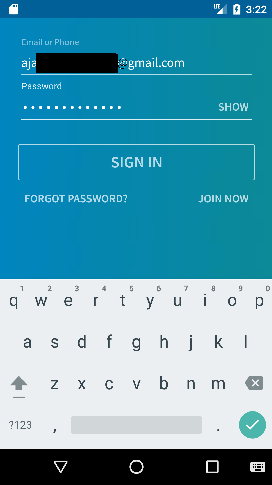
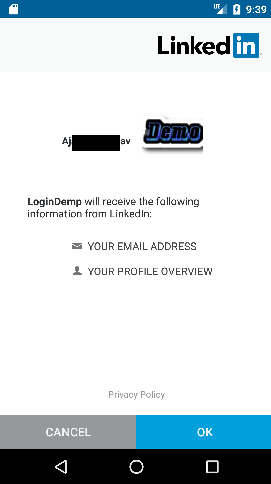 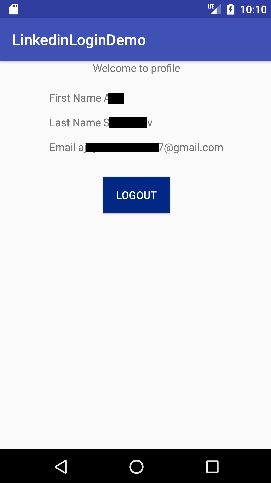
Next TopicIntegrating Twitter
|
Related Links:
- Android MediaRecorder example
- Learn Android Tutorial | Android Studio Tutorial
- Android Custom RadioButton
- Android AlertDialog Example
- Android Spinner Example
- Android Versions
- Android Watch
- Android Seekbar example
- Android DatePicker Example
- Android TimePicker Example
- Android Sqlite Tutorial
- Android SQLite Example with Spinner
- Android XML Parsing using SAX Parser
- Android RSS Feed Reader
- Android Linkify Example
- Android AutoCompleteTextView Example
- Android ListView Example
- Android AlarmManager
- Android Google Map Search Location using Geocodr
- Android Emulator
- Android Auto
- Android File Transfer
- Android Hide Title Bar Example
- Android TextToSpeech Tutorial
- Android TextToSpeech Example
- Android Volley Library - Registration, Log-in, and Log-out
- Android ScrollView Horizontal
- Android Network Connectivity Services
- Android Messages
- Android Oreo
- Android TV
- Android Screenshot
- Android Custom CheckBox
- Android RadioButton
- Android Dynamic RadioButton
- Android StartActivityForResult Example
- Android Share App Data
- Android Fragments
- Android Simple Graphics Example
- Android Animation Example
- Android Image Switcher
- Android Image Slider
- Android Quiz | Android Online Test
- Android Option Menu Example
- Android Context Menu Example
- Android Popup Menu Example
- Android Web Service | Android Restful Web Service
- Android Google Map
- Android Google Map displaying Current Location
- Android Service Tutorial
- Android External Storage Example - TheDeveloperBlog.com
- Adding Android Interstitial Ads
- Android QR Code / Bar Code Scanner
- Android Custom ListView
- Android RatingBar Example
- Android WebView Example
- Android Preferences Example
- Android Internal Storage Example - TheDeveloperBlog.com
- Android Analog Clock and Android Digital Clock Example
- Android ProgressBar Example
- Android ScrollView Vertical
- Android XML Parsing using DOM Parser
- Android XMLPullParser Tutorial
- Android JSON Parsing Tutorial
- Android ViewStub
- Android Intro Slider Example
- Android RecyclerView List Example
- Android Swipe to Delete RecyclerView items with UNDU
- Android Telephony Manager Tutorial
- Android Call State Example
- Android Call State BroadCastReceiver Example
- Android Firebase Authentication - Google Login
- Android Notification
- Android TabLayout
- Android TabLayout with FrameLayout
- Android SearchView
- Android SearchView on Toolbar
- Android Caller talker example
- Integrating Google Sign-In in Android App
- Integrating LinkedIn API in Android App
- Integrating Twitter API in Android App
- Android Device Manager
- Android Studio
- Android Interview Questions (2021)
- Android EditText with TextWatcher
- Android Activity Lifecycle
- Android Screen Orientation Example
- Android Intent Example
- Android Explicit Intent Example
- Android Bluetooth Tutorial
- Android bluetooth list paired devices example
- Android Wifi Example
- Android Camera Tutorial
- Android Sensor Tutorial
- Android Custom Toast Example
- Android ToggleButton Example
- Android Checkbox Example | Food Ordering Example
- What is android
- History of Android
- Android Architecture | Android Software Stack
- Android Core Building Blocks | Fundamental Components
- Android Widgets Tutorial
- Android Button Example
- Android Toast Example
- Adding Android Google Admob
- Adding Android Banner Ads


